Family : Burhinidae

Text © Dr. Gianfranco Colombo

English translation by Mario Beltramini
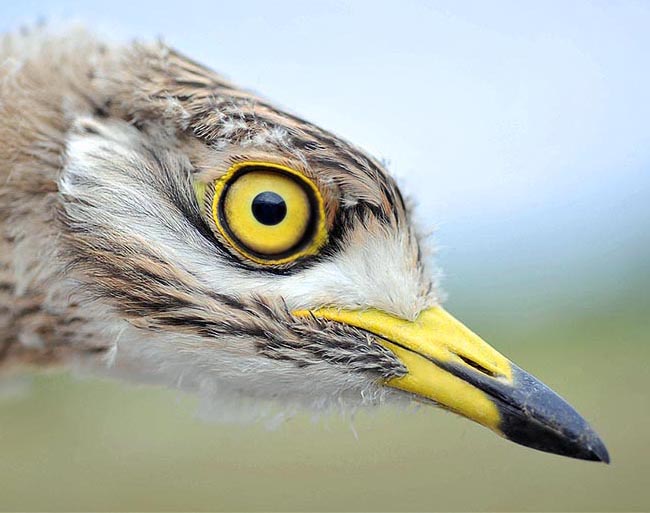
Burhinus oedicnemus has owl eyes, with very big and squared head © Gianfranco Colombo
As we shall see later on, a bird having owl eyes, very big and squared head, long gnarled and sinewy legs, strong and robust beak, highly camouflaged colour, excellent runner, migratory alar conformation and crepuscular and night activity.
Nevertheless, this bird belongs to the order of the Charadriiformes, the same as the well known Common lapwings (Vanellus vanellus), the Common snipes (Gallinago gallinago) and the ubiquitous gulls but is assigned to the particular family of the Burhinidae.
These have frenetically attracted the ornithologists of the countries where these birds do live and through studies and thorough observations, they have come to determine some unknown characteristics and to decribe their most intimate behaviours.
From these findings they have come to quantify its populations with a pretty good approximation, discovering that from rare or occasional as was formerly considered, it is on the contrary a well diffused bird in most of our territory though not constantly and never in high number.
Being able to see this bird is not for everyone and only the trained eye is able, at times with considerable difficulty, to trace its presence. Although living in open and without vegetation sites, actually in completely bare and stony areas, we might imagine an easy thing to be able to identify a bird of such a size. Conversely, it can be probably considered as one of the most difficult to observe. Perfectly still, standing on its long legs, behind a large stone on the bed of a dried-up river or in the shade of a clump of weeds or of a piece of wood, it keeps motionless for hours without blinking.
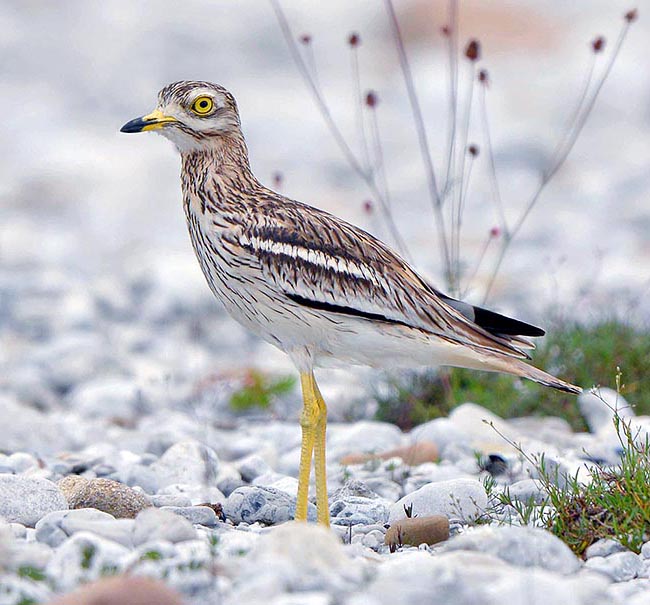
Completely still for hours erect on its long gnarled legs, strong and robust beak, highly mimetic colour, <br />great runner with migrant alar conformation, of dusk and night activity © Gianfranco Colombo
Although observing it we wonder often if it is an inanimate object with its shape or a real stone curlew.
Moreover, living in very dry and sunny places and having to observe it from notable distance due to its shyness, the reverberation of heat on the ground further distorts the vision rendering problematic the already difficult identification.
It is even more difficult to discover the female on the nest. Even if it remains fairly erect while hatching, it is practically invisible and integrated in the surrounding environment. It’s practically a differently coloured stone among the stones of a scree.
Then it happens that feeling observed even from fairly distance while trying to get back to the nest from which we have inevitably moved it when it has discovered our approaching, implements strategies of extreme and unthinkable intelligence.
Moving almost in slow, agonizingly slow, motion, with the body slightly bent forward, neck and head stretched and lowered and the legs slightly bent, now, after a few metres covered in some minutes, it leans on the ground ruffling the feathers of the belly as normally does a bird on the nest.
Well, the stone curlew carries out this trick several times before leaning on the real nest, playing with the observer who is under the illusion, already since the first approach, of having discovered it.
The vulgar names given to this bird are different and quite various but all of them are modelled on some peculiarities typical of this bird. The Anglo-Saxons call it indifferently Thick-knee, due its swollen joints, Stone curlew, due to the environment where it lives and due to the resemblance of its singing to that of the curlew or Dikkop = “large head”, borrowing the name from the Afrikaans term “dik” = big and “kop” = head and associating it to the other two species present in the African continent. Other European names are Triel in German, Oedicnème criard in French, Alcaraván Común in Spanish, and Alcaravão in Portuguese. In Italy is generally and par excellence the Occhione due to its disproportioned eyes but regionally it may be the libbrazzina – leveret, due to its way of crouching on the ground, or the ciulluvì or the zurrulliù in imitation of its singing or franculinu in the Mediterranean islands.
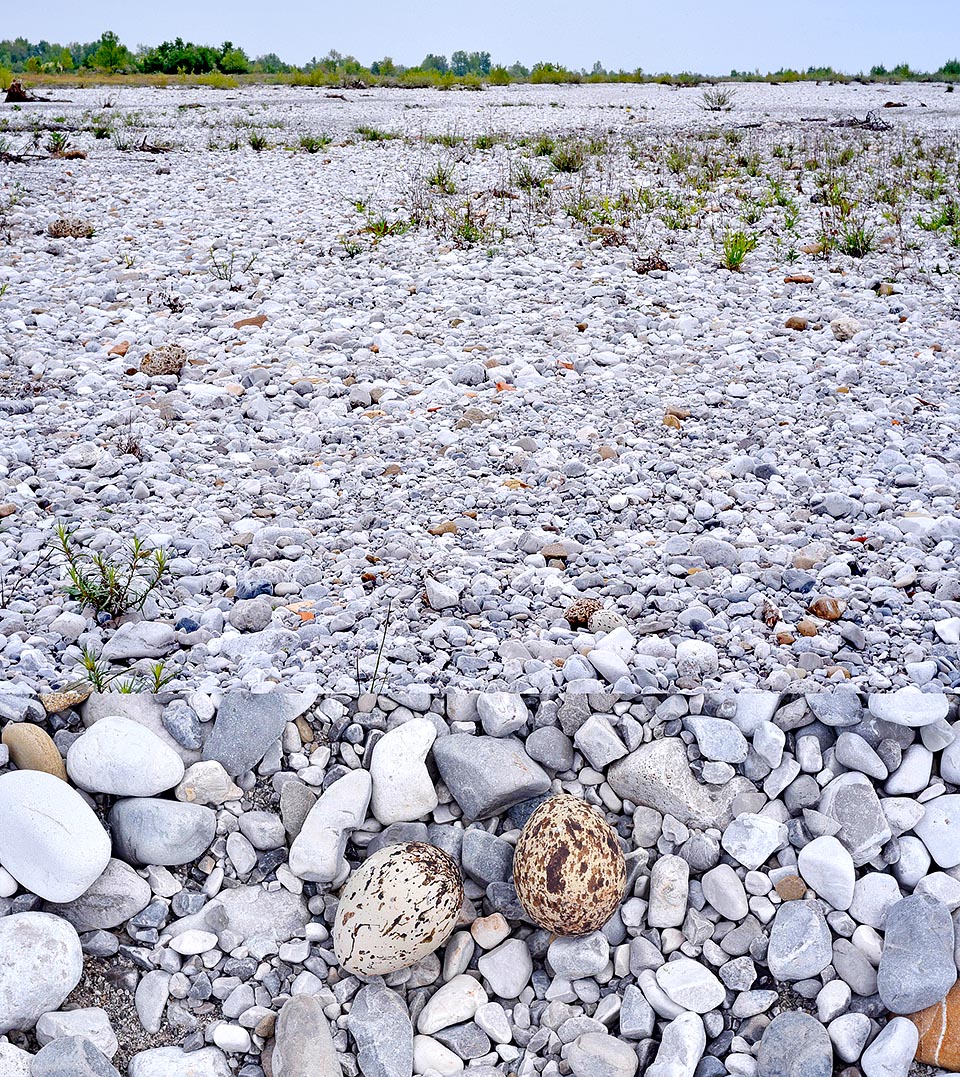
It's not for all to be able to see this bird. There is no nest and on the dried riverbeds the eggs really look like pebbles © Gianfranco Colombo
The etymology of the scientific name comes from the old Greek: Burhinus from “bous” = ox and “rhis” = nose or beak, referred to the big beak whilst oedicnemus from “oidio” = to swell and “kneme” = leg in reference to the swelling it has in the tibio tarsal joint.
Zoogeography
The stone curlew has a wide, but quite fragmented, range. In Europe, it lives in France, in southern England, in the Iberian Peninsula and in Italy, with a good concentration in the Po Valley and in the southern part of the peninsula. It’s absent in Central Europe and in the Scandinavian Peninsula, but is present in the eastern zone, continuing then in Asia, in the central part up to China and in the south of the continent up to the Indochinese Peninsula. In Africa is present along the Mediterranean coasts of Morocco, in Tunisia, Cyrenaica and Egypt, reaching the Asian territory in Jordan.
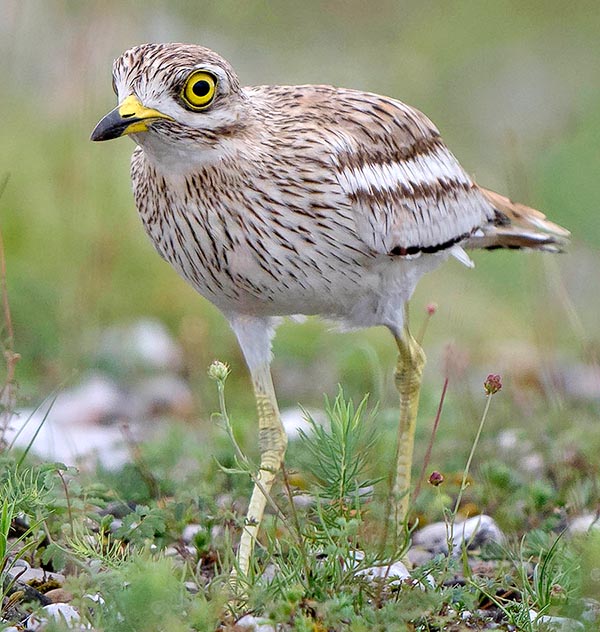
Burhinus oedicnemus has vast but quite fractioned range. Migrant or sedentary depending on the zones, is present in Eurasia up to China and in Mediterranean and sub-Saharan Africa © G. Colombo
Typical are the Spanish and the Greek popoluations and occasionally the Italian one too.
Also the Indo-Malay population is sedentary in its range besides absorbing most of the migration coming from Central Asia.
The European population migrates in Africa, in the sub-Saharan area in two distinct zones.
In the western part, in Mali and Burkina Faso, in Sierra Leone, Guinea Bissau and Guinea Conakry and in the eastern part, in Eritrea, Ethiopia, Somaliland and Kenya.
Some Asian populations hibernate also on the western coast of the Arabian peninsula.
About ten subspecies have been determined, mainly linked to populations confined in particular locations.
Ecology-Habitat
The ideal habitat of the stone curlew are the open spaces with sparse herbaceous vegetation, dried up river beds and pebbly lands, uncultivated meadows with sparse brushwood but with common characteristic an ample vision all around.
It is often found in plowed fields recovered from previous abandoned fields, showing a strong link to the possibly native area even if later on modified by the modern agriculture.
It is not a species linked to the water though being a wader, therefore has transformed the arid areas in its reign.
Almost invisible by day thanks to its strong camouflage and to the reluctance shown towards any intruder, perfectly integrating with the surrounding nature, it made of the night the moment of greatest activity.
When in the dark, the stone curlew is quite talkative and since from the nightfall it begins to emit its monotonous but melodious singing that spreads all around for kilometers. A song repeatable in curliip curliip, with elongations of the last syllable and emitted at regular intervals. A singing quite similar to that of the curlew, so much to get the English name described in the previous chapter, that is immediately returned by the neighboring specimens, creating a concert that continues in the night, accompanied by the croaking of the Nightjar (Caprimulgus europaeus) with whom invariably shares the territory.
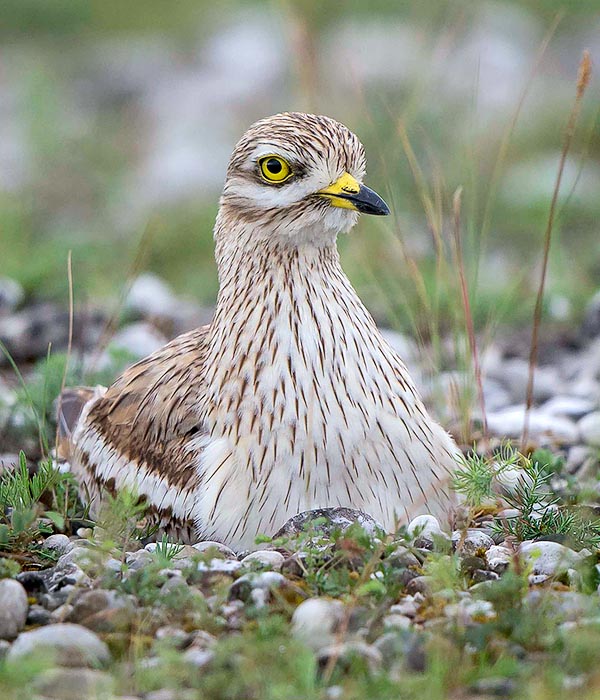
It's almost impossible to discover a hatching female © Gianfranco Colombo
The stone curlew can easily fly during the night due to its disproportionately large eyes nature has given him. This fact is surely facilitated also by the absolute absence of trees in the area it lives. In the dark, it gathers often in noisy groups usually on sandy spaces, where it carries out its only social activity.
In this regard, it has been noted that this bird, usually solitary during the nidification period, gathers in groups also very significant before migrating, meeting in predetermined locations before beginning the voyage towards the winter quarters.
The stone curlew mainly nourishes of insects, eartworms, small reptilians and also of tiny rodents it seizes with the robust beak and gulps down whole.
Morpho-physiology
Even if the stone curlew has done of the camouflaging and of the invisibility its strong points, its dimensions are unexpected and totally unforeseen.
The wingspan may reach the 90 cm, the length more than 40 cm and the weight, during the period coming before the autumn migration, more than 500 g.
It has a specialized livery that integrates perfectly with the surrounding soil so much to render it often invisible. It is, how often they say, a true mimetism master. On the back and on the head is of yellowish ochre colour streaked by lines, spots and black bars. On the wings, at the height of the primary remiges is present a longitudinal white stripe paired to a black heterochromatic one that practically acts as trompe l’oeil with the surrounding environment. The chest is slightly whitish spotted brown.
The face has whitish cheeks bordered by a narrow brown belt where are enshrined two huge bright yellow eyes, like an owl.
The straight and sturdy beak, about 4 cm long, is yellow with blackish tip. Also the paws are yellow with evident and abnormal enlargement of the knee. Vigorous legs and three very strong fingers for a real racer specialized in walking on uneven and stony ground. When flying it shows two evident white alar belts. There is no sexual dimorphism and the young are very similar to the adults.
Ethology-Reproductive Biology
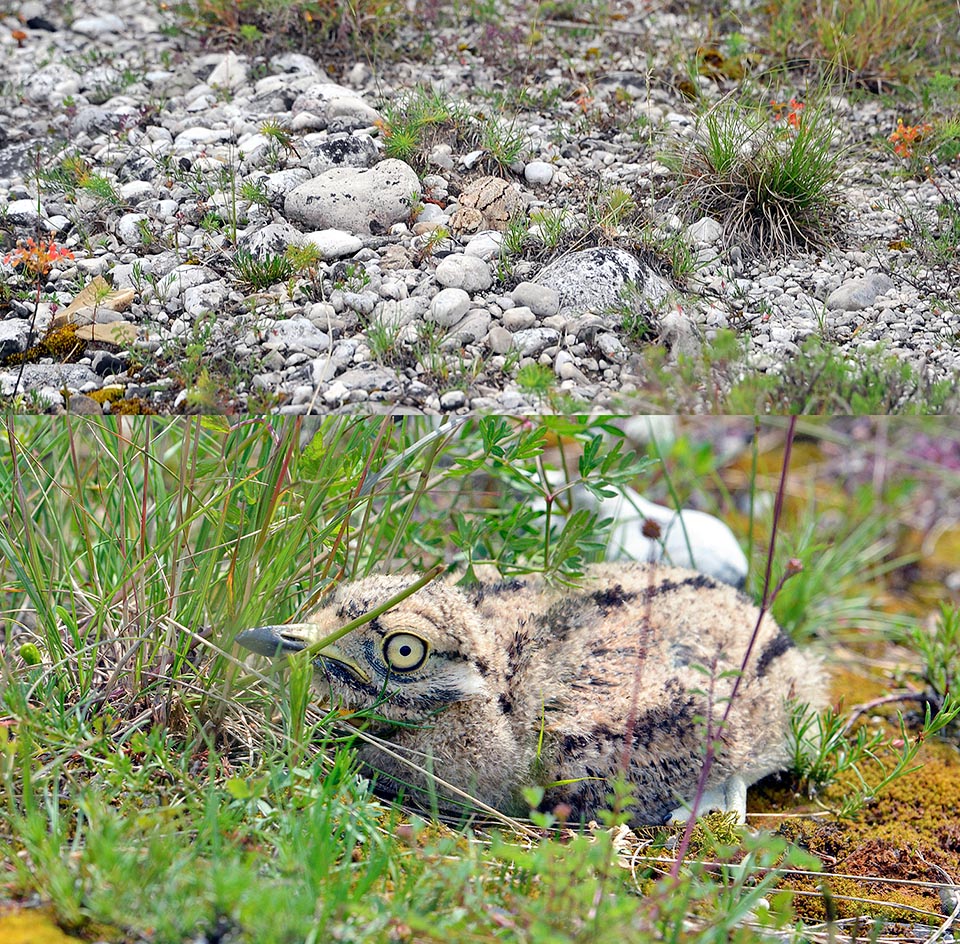
This bird eats mainly insects or earthworms but also, if the case, small reptilians and mice it gulps whole. When the chick can scamper it’s taken nearby in a grass or low vegetation covered space where, if left alone, disappears in the environment. It has a specialized livery that integrates perfectly with the surrounding soil © Colombo
The stone curlew has an unpredictable nidification period and often linked to the climate trend of the place where it lives. Usually, it nidifies by late spring but are known instances of early nidification from February and also late ones in autumn.
Usually, only one deposition is done even if it can be rapidly replaced in case of accidental loss of the first brood.
It lays two, rarely three, fairly big eggs of cream colour strongly brown dotted that it puts directly on the ground among the pebbles and without carrying there any material.
Initially, the male digs some small holes in the ground, usually not too far each other and after a few hours the female chooses the one where she will lay. Even if the nest is usually bare, at times around the eggs it collects small stones or hares and wild rabbits dung but always in negligible quantities so not to make the nest visible.
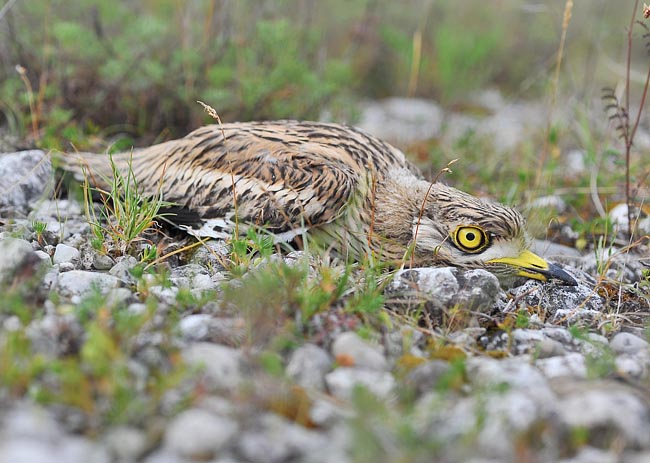
Young learn to fly only when 6-7 weeks old and only defence from predators is mimicry © Gianfranco Colombo
The brooding lasts about 23 days and the chicks come to life already feathered and ready to leave the nest after a very few hours after the hatching. The stone curlew nidifies, as aforementioned, in areas totally barren and without vegetation, but takes the precaution to build it close to a space covered by grass or by low vegetation, where it promptly transfers the young as soon as they are capable to scamper.
During the hatching the male keeps perpetually on guard in the surrounding, hidden among the bushes and always careful to any even minor movement and warning the female at any slightest danger.
On the other hand, the female when crouches on the nest usually turns always its back to that side in order to keep under control the other half of the horizon. A teamwork that does not allow the possible intruder to sneak up and catch off guard the female while breeding.
The young are cared by the parents for various weeks before becoming totally autonomous and take off only after about 6-7 weeks from the birth, thus remaining unable to fly even if they have already reached the size of an adult.
During this time camouflaging becomes even more necessary in order to avoid the predation by terrestrial enemies apart the flying raptors.
The stone curlew has many natural foes. Foxes and martens, harriers and buzzards, but even more insidious is the danger caused by the flocks that, while crossing its reproductive zones, inexorably trample everything they find during their passage, nests included.
Also the sudden floodings of streams and rivers on which banks they nidify, stand among the accidental causes of their nests destruction.
It is not included among the endangered species even if in some areas it is in strong decrease because of the transformation of the territory. In Italy it is considered as a particularly protected species.
Synonyms
Charadrius oedicnemus Linnaeus, 1758.
